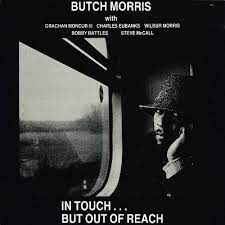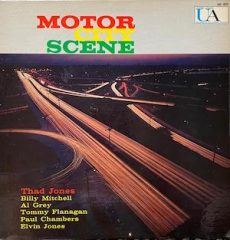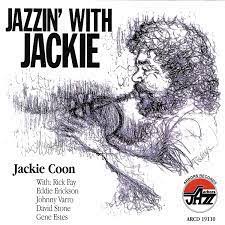
Daily Dose Of Jazz…
Butch Morris was born Lawrence Douglas Morris on February 10, 1947 in Long Beach, California. Before beginning his musical career, he served in the U.S. Army as a medic in Germany, Japan and Vietnam during the Vietnam War. He came to attention with saxophonist David Murray’s groups in the late 1970s and early 1980s.
>Morris led a group called Orchestra SLANG. The group features drummer Kenny Wollesen, alto saxophonist Jonathon Haffner, trumpeter Kirk Knuffke and others. He performed and presented regularly as part of the Festival of New Trumpet Music, held annually in New York City. He wrote most of the incidental music for the 1989 TV show, A Man Called Hawk, which starred Avery Brooks, with whom he co-wrote the theme music, along with Stanley Clarke. He also played with well-known artist and would-be drummer A.R. Penck in 1990.
The originator of Conduction (a term borrowed from physics), a type of structured free improvisation where Butch directs and conducts an improvising ensemble with a series of hand and baton gestures.
Cornetist, composer and conductor Butch Morris, known for pioneering his structural improvisation method Conduction, transitioned from lung cancer on January 29, 2013, at the age of 65 in New York City.
More Posts: bandleader,composer,conductor,cornet,history,instrumental,jazz,music

Daily Dose Of Jazz…
William Crickett Smith was born on February 8, 1881 in Emporia, Kansas, the child of Tennessee Exodusters. His professional career began in childhood, performing in Nathaniel Clark Smith’s Picaninny Band before moving into minstrel troupes, vaudeville and cabaret.
In 1913-1914, he made several early recordings with James Reese Europe’s group, the Clef Club Society Orchestra. Between 1914 and 1919, he performed in the Ford Dabney Orchestra, the resident band at Florenz Ziegfeld’s Broadway cabaret, Midnight Frolics. Between 1917-1919, they produced several dozen phonographs.
By 1919 Smith had relocated to Paris, France playing with Louis Mitchell’s Jazz Kings until 1924. The group recorded for Pathe Records. He became the leader of Mitchell’s group in 1923. He went on to tour France, Spain and Russia with his own bands from 1925 to 1933. However, during the Depression, he spent nine years in Southeast Asia, working with Herb Flemming, Leon Abbey, and Teddy Weatherford, mostly in Bombay and Batavia. In 1936, he recorded with a group called the Symphonians.
Around 1943 cornetist and trumpeter Crickett Smith, who played jazz blues and ragtime, returned to New York City and the following year transitioned on August 30, 1944.
More Posts: bandleader,cornet,history,instrumental,jazz,music,trumpet

Daily Dose Of Jazz…
Merritt Brunies was born on December 25, 1895 into a well-known musical family in New Orleans, Louisiana. Among its members were trombonist George Brunies and cornetist Albert Brunies.
Merritt led his own band, The Original New Orleans Jazz Band, from 1916 to 1918. Though this ensemble never recorded, it existed before both Jimmy Durante’s New Orleans Jazz Band and the Original Dixieland Jazz Band. Following this, he formed another group which played at Friar’s Inn in Chicago, Illinois directly after the stint by the New Orleans Rhythm Kings.
He played regularly in New Orleans in the 1930s, however, by 1946 he moved to Mississippi. There he played with his brothers in a Dixieland jazz band until his retirement. Trombonist and cornetist Merritt Brunies transitioned on February 5, 1973 in Biloxi, Mississippi.
More Posts: bandleader,cornet,history,instrumental,jazz,music,trombone

Requisites
Motor City Scene ~ Thad Jones Sextet | By Eddie Carter
This morning’s record submitted for your consideration is Motor City Scene (United Artists UAL 4025/UAS 5025) by The Thad Jones Sextet. It hit the stores in 1959 and consists of tunes composed by the leader. Thad comes from a musical family; both his brothers were excellent musicians. His older brother Hank was a consummate pianist, and his younger brother Elvin was a dynamic drummer whose birthday was recently observed on September 9. The ensemble is Thad Jones on cornet (tracks: A1, B1, B2), and flugelhorn (track: A2), Al Grey on trombone, Billy Mitchell on tenor sax, Tommy Flanagan on piano, Paul Chambers on bass, and Elvin Jones on drums. The copy used in this report is a friend’s US original Mono deep groove album.
Side One gets underway with Let’s Play One, an easy-going blues that Tommy opens with a brief introduction that evolves into the sextet’s collective theme. Tommy starts the solos with a relaxing presentation, next Al comes in for a laid-back statement. Billy steps up next to give a marvelous reading, then Thad contributes a very pleasant presentation. Paul walks leisurely into the finale preceding the ensemble’s finish. Minor on Top picks up the pace gradually on the group’s lightly-swinging melody. Thad leads off with a charming flugelhorn statement, then Billy hits a relaxed groove on the next solo. Paul constructs a delicious bass performance next. Al delivers the next reading with absolute assurance, followed by Tommy and Elvin who share an attractive exchange into the closing chorus.
Like Old Times takes the tempo up a few notches to start Side Two with the front line leading a brisk melody. Billy takes the lead this time with a swinging solo. Tommy says his piece next in a rollicking reading. Al romps through a lively presentation next. Elvin makes a brief appearance, followed by Paul who puts together a passionate performance. Thad gets the last word and cooks on muted cornet leading to the sextet’s ending. No Refill begins with a soft introduction by Elvin segueing into the sextet’s soothing opening chorus. Thad’s first solo on muted cornet is restrained in its mood of gentle warmth and graciousness. Billy handles the second statement discreetly, and Tommy adds the exclamation point with a thoughtful performance ahead of the sextet’s ending theme and slowly fades into silence.
Motor City Scene was produced by Tom Wilson, and the man behind the dials was Lewis Merritt. I was impressed with the sound quality of the recording. The album has a superb soundstage with vivid sonics. The instruments emerge from your speakers as if the sextet’s playing in front of your favorite chair and the record is quiet for its age. Thad and his colleagues are in excellent form throughout, and this album highlights Thad’s ability as a composer. If you’re a Hard-Bop fan, I invite you to check out Motor City Scene by The Thad Jones Sextet, the next time you’re out shopping for records. It may be hard to find, as the few LPs I’ve seen online are already at collector’s prices, but your diligence will be rewarded with a great album for your library that’s highly recommended!
© 2022 by Edward Thomas Carter
More Posts: choice,classic,collectible,collector,cornet,history,instrumental,jazz,music

Daily Dose Of Jazz…
Jackie Coon was born in Beatrice, Nebraska on June 21, 1929 and grew up in Southern California. He was inspired to play trumpet after hearing Louis Armstrong’s West End Blues. He spent a few months with Jack Teagarden’s band and had gigs with Charlie Barnet, Louis Prima, and Earl Hines.
Making his recording debut with Barney Bigard in 1957 and he also played the mellophone on Red Nichols’ version of Battle Hymn of the Republic. Jackie’s decision to stay in California cost him the fame that eluded him, but he worked at Disneyland for nine years, and performed regularly in local clubs and jazz festivals.
It was until 1986 that Coon led his first record session for Sea Breeze. Since 1991 he has recorded fairly often for Arbors. Trumpeter, flügelhornist and cornetist Jackie Coon has become less active in his Eighties.
More Posts: bandleader,cornet,flugelhorn,history,instrumental,jazz,music,trumpet




